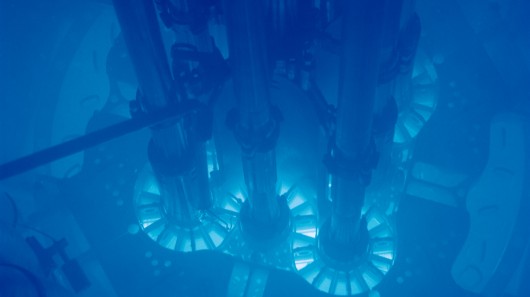Hitachi developing reactor that burns nuclear waste
By David Szondy
September 3, 2014

Hitachi is developing a new reactor that burns transuranium elements, such as those produced by this advanced test reactor at Argonne National Laboratory (Image: Argonne National Laboratory/Wikimedia)
The problem with nuclear waste is that it needs to be stored for many thousands of years before itís safe, which is a tricky commitment for even the most stable civilization. To make this situation a bit more manageable, Hitachi, in partnership with MIT, the University of Michigan, and the University of California, Berkeley, is working on new reactor designs that use transuranic nuclear waste for fuel; leaving behind only short-lived radioactive elements.
In popular imagination, nuclear waste is a wildly radioactive goo that glows like the back end of a lightning bug. But in real life, the real problem of nuclear waste isn't the "hot" stuff, but the mildly radioactive elements with atomic numbers greater than 92. Thatís because highly radioactive elements have short half lives. That is, they burn themselves out very quickly Ė sometimes in a matter of minutes or even seconds.
On the other hand, mildly radioactive elements, such as plutonium, have half lives measured in tens of thousands or even millions of years. That makes storing them a very long-term problem, and is a particular difficulty in countries like the United States that donít recycle transuranium elements by fuel reprocessing or fast-breeder reactors.
What Hitachi and its partners are trying to do is to find ways to design next-generation reactors that can use the low-level transuranium elements as fuel; leaving behind the high-level elements to quickly (relatively speaking) burn themselves out in no more than a century or so.
Thatís not a particularly new idea. Some modular nuclear reactors already use nuclear waste as fuel. But what sets Hitachi apart is that it's looking into designs based on current boiling-water reactors that are known as Resource-renewable Boiling Water Reactors (RBWR) and are being developed by Hitachi and Hitachi GE Nuclear Energy Ltd.
The idea is to develop a new fuel element design using refined nuclear waste products along with uranium that can be installed in a standard boiling water reactor. This would not only make such reactors more economical to build, but would also use decades of safety and operations experience to achieve efficient nuclear fission in transuranium elements.
Hitachi says that itís already carried out joint research with its partners starting in 2007 and is now concentrating on the next phase, which deals with more accurate analysis methods, as well as reactor safety and performance, with an eye toward practical application of whatís been learned.
Source: Hitachi
copyright © Gizmag 2003 - 2014